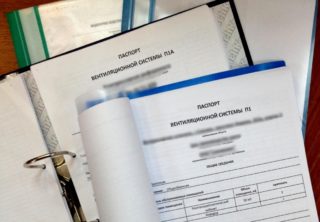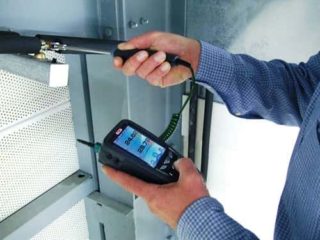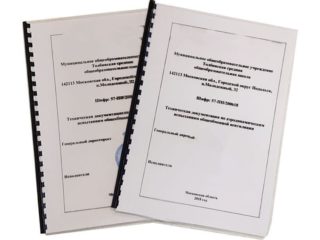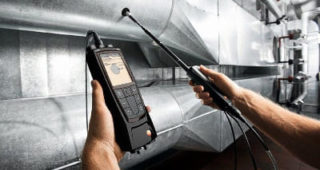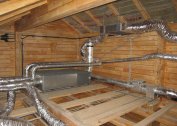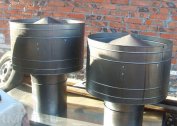Inspectors during the inspection require the owner of the building passport ventilation system. The document describes the technical parameters and the device trunk. The control act is issued by a special commission, it confirms the compliance of the results of aerodynamic tests with standard indicators. Certification is carried out for all types of systems, a technical document is drawn up after completion of installation and testing.
Description and need for certification of the ventilation system
The owners of the building attract unskilled workers for installation of the ventilation pipeline in order to save money. Verification of work is carried out without calculations and special devices.
Unreasoned savings result in inefficient work and entail consequences:
- the highway does not cope with the tasks;
- there are problems with regulatory authorities;
- there are additional costs for troubleshooting and paperwork.
The owner of the building is interested in proper installation and qualified certification. Service employees carry out an instrumental check and draw up a certificate of compliance only with positive test indicators.
Certification is required:
- company employees to work in comfortable conditions;
- to the head and engineering staff to correct deficiencies in the system, to carry out maintenance and scheduled repairs;
- to the owner of the organization to avoid fines.
According to SanPiN 2.1.3.2630 - 10 mounted ventilation ducts of the supply and exhaust mechanical type must have a technical document.
Who issues a passport
Testing the ventilation duct system is done using anemometers, manometers, and other special equipment.
Inspection and certification are carried out by specialized companies:
- Installation and construction organization, if the contractor has a design department and adjusters. Practice shows that even large firms do not have such an engineering staff, for example, the staff does not have a qualified chief engineer.
- Testing laboratories that do certification tests, and technical equipment provides high-quality measurements. Sometimes in such organizations there are no engineering workers in the ventilation specialty, therefore they cannot decipher and correlate the obtained indicators.
- Special associations and organizations carry out tests, diagnostics and draw up a ventilation system passport. They have highly qualified specialists and a base equipped with the necessary equipment and devices.
If the preparation of documentation for ventilation is done after the start of the actual operation, the owner turns to a specialized company. In addition to the passport, checks are required, which are also reflected in the technical papers.
Maintenance and operation of the pipeline is carried out by the responsible employee of the organization. Disinfection and cleaning is done at least once a year, repairs are carried out as necessary.
Customer-Contractor Interaction
At the first stage, experts inspect the highway and identify congruency or non-compliance with the project. An act of defects is drawn up, where problems are described, and proposals for their elimination are given.
The main causes of malfunctions in the ventilation line:
- low-quality materials are used for the manufacture of boxes, shaped elements and other details;
- construction and installation works were carried out in violation of technology;
- the installed equipment does not correspond to what is provided for in the project;
- starting activities are carried out by unskilled workers or a test run was not carried out at all;
- Designers errors
- units in the system are not coordinated according to technical conditions and are not ready for work;
- Embedded systems are not operating properly.
The customer makes repairs and fixes all the problems that the inspectors found. After that, the experts again do an analysis and a health check. Based on the results, a ventilation system passport is compiled. These checks are reflected in the technical report, which provides information about the type of the analyzed object and the test time. In the form of a table, information is provided on the air exchange rate, microclimate quality, noise level and other indices.
The frequency of testing is determined by regulatory provisions:
- STO NOVOSTROY 2.24.2 - 2011 indicates in the text that the frequency of setting up air conditioning and ventilation is set by the federal executive branch or technological requirements of production and cannot be less than 1 time in 3 years.
- GOST R 53.300 - 2009 governs the testing of the smoke system at least once every 2 years.
- SP 44.25 - 87 says that active ventilation systems are periodically checked by sanitary laboratories. In places of categories 1 and 2, where there is a release of harmful air components - 1 time per month. Closed local supply and exhaust ventilation systems - once a year, and natural and mechanical ventilation schemes are checked once every 3 years.
The ventilation passport is updated after each conversion of production technology, equipment changes, reconstruction and reconstruction of premises. A new document is made immediately after the change, regardless of the timing of the periodic review.
Samples and examples of passport ventilation system
The technical document of the ventilation system reflects all the transformations during installation and during operation. Records are updated regularly during refurbishment or periodic inspections.
The protocol conclusions of aerodynamics testing and acts of inspections during the events are attached to the passport:
- checking fan performance depending on the pressure difference in the line;
- inspection of the tightness of the joints of the pipeline and joints;
- noise isolation control and vibration detection;
- investigation of the occurrence of excessive pressure in control plots.
The passport contains about 8 pages, which are stitched in the workshop or connected by a spring. Additionally, a protocol on the replacement of constituent elements or their replacement is presented. Recommendations for the operation of the pipeline are attached in an abridged version. If the installer saves the results of research and work in electronic form, a note is put in the passport stating that there are such protocols, and an address is given for receiving them if necessary.
Passport for ventilation system
The microclimate quality is assessed in the installation area. The temperature, humidity, air mobility are investigated. Noise in the ventilation system is caused by a lack of insulation, unbalanced fans or a small diameter duct. Heat is lost through the system, if the duct is not protected from the cold, heating costs increase. If humidity rises regularly, fungus and mold appear.
The procedure for compiling a passport for ventilation:
- measured dimensional parameters of boxes, bends and fittings;
- the air pressure at the outlet and inlet is determined;
- the correspondence of the actual turnover of flows and the calculated rate of air exchange is checked;
- measured air speed;
- the cleanliness of the internal space and the presence of randomly caught objects are checked;
- the condition of the insulating shell is examined;
- an expert opinion and an act of completion are drawn up.
Visual representation of pollution and obstacles in the air is obtained using modern video equipment. Technologies use remote robotic cameras, which are placed in the duct duct.
Passport for ventilation unit
The study of the ventilation line during certification includes aerodynamic tests using a specific technique. Measuring equipment is used in a standard manner with the expectation of statistical errors. Aerodynamic drag is checked on the sections of the main channel and branch channels, the mine structure is investigated.
The indicators identified during the test are compared with theoretical data, and a conclusion is drawn about the factors affecting the change in working indices.
The passport describes the structural elements:
- coordination links, for example, dampers or turbine control devices;
- heat exchange system between incoming and outgoing flow (recuperation scheme);
- electric motors, their type and characteristic.
During start-up and commissioning, the valves and devices that organize the flows are regulated to a state where the output parameters will correspond to the design values. The technical document must be filled in when changing the owner or losing the old sample passport of the ventilation system.
Passport of ventilation according to SNiP
A sample passport of the ventilation system and its component sections are given in SNiP 3.05.01 - 1985 “Internal Plumbing Systems”. The passport for ventilation installations is regulated by the text SNiP 44.01 - 2003 “Heating, air conditioning and ventilation”.
The description indicates:
- the address of the investigated object and its purpose;
- system characteristics;
- layout diagram of equipment in axonometric projection with indication of control sections and test points;
- technical documents for fans, coolers, filters, air heaters, etc.
An example of filling in the passport of the ventilation system in 2020 in terms of compliance with sanitary and technical parameters is in SanPiN 2.2.2.548 - 1996 “Hygienic requirements for the indoor climate”.
The organization that certifies the smoke system must have a license from the Ministry of Emergency Situations, in other cases a work permit from the SRO is sufficient - a self-regulatory organization that monitors and develops uniform quality and production standards.
Maintaining a passport and its cost
New passports are compiled when the ventilation pipe is commissioned, but entries in the text of the document are added regularly during inspections. Information is entered into special tables, it is made by a responsible person, for example, an energy engineer or an enterprise mechanic. If the organization does not have such employees, specialists are hired. A lot of protocols accumulate during prolonged operation of the system, so only the first and last 5 options are left.
The cost of the passport is given in the estimated calculation, which is agreed with the customer before work. Retesting is usually done at a discount if previous experts are involved. The price depends on the size of the facility, branching of the trunk and the number of equipment involved in the pipeline. The approximate cost of examining and compiling a passport is 3 thousand rubles including VAT.
